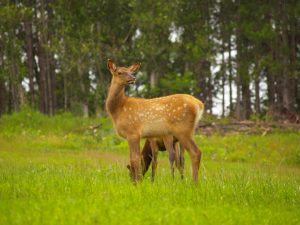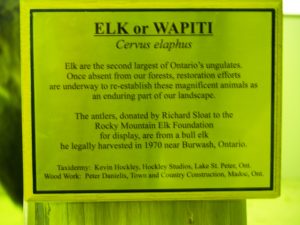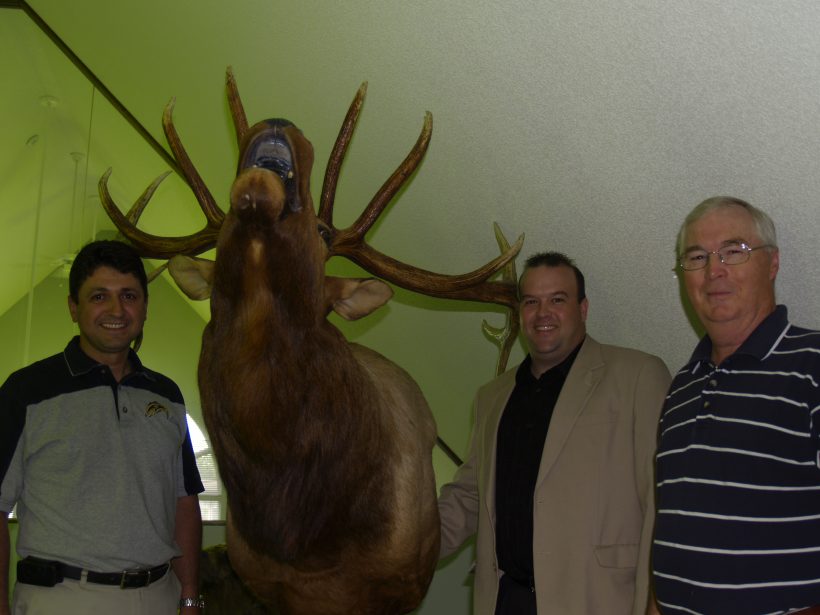The Last Elk hunt
Or, perhaps more correctly, the last documented legal elk hunt in Ontario. In fact a core group of elk in the Nipissing-French River area, numbering between 50-60 animals in 1996, survived the Ontario government’s purge of the 20th century due to an unfounded concern that they were infecting domestic cattle with the giant liver fluke parasite. Hunters were permitted to take an elk on their deer licence until 1979 when MNR biologist Bruce Ranta is credited with putting an end to that practice. Working towards his MSc studying the Burwash elk, Ranta became a driving force in the restoration of Ontario’s elk. “I told people that these animals were once native here and explained that they had survived and adapted against tough odds,” he said. In February 1997 then Minister of Natural Resources Chris Hodgson committed to the elk reintroduction program.
A Little History
In 1914, the beginning of World War 1, the Burwash area became home to a medium security prison farm called the Burwash Correctional Centre. This was not for hard core criminals and apparently no one stayed more than two years. Burwash became self-sustaining with its own hospital, dairy farm, post office, chapel, power station, pump house, sewage treatment, farm, schools, sawmill and logging operations which included tree planting.
At one point the farming operation was also home to buffalo and elk. The giant liver fluke episode mentioned earlier meant that all of the farm elk had to be put down. However, sympathetic to the elk, some workers let a number of the animals escape.
In 1974 the government shut down Burwash and it soon became a ghost town. The grasslands created by farming provided valuable elk habitat amidst the rough and rocky Precambrian Shield. Approximately 30 elk formed a wild herd. As mentioned, until 1979, deer hunters could take an elk on their tag.
By 2007, the Burwash elk population had grown to some 150 animals in part due to the first releases of elk from Alberta in 1998 and 1999. Initially the newly re-introduced Elk Island elk did not mingle with the native herd but given time that did take place.

The Last Hunt
Richard Sloat’s gang hunted in the Millard lake-Burnt Lake-Horseshoe Lake area, not that far from the Burwash Medium Security farm. Tuesday November 2, 1970, proved to be a nice crisp, sunny day. There were 6 in the hunting party – Richard’s father Roy, his uncle Joe, brother Ron, the camp owner Andy Gibson and Andy’s friend Don Montgomery. “Then you could shoot elk or bear on a deer licence,” said Sloat. They didn’t use dogs. Sloat took a boat to Horseshoe Lake where he climbed a hill overlooking all of the three previously mentioned lakes. The guys had agreed upon a rendezvous and Sloat remembers thinking that he had better get moving if he was to meet them on time. He recalls moving about 5 feet when suddenly he heard a loud “crack!” Looking in the direction of the sound he saw a flash of light as the sun reflected off an antler. Within seconds Sloat saw a bull come fully into view “coming right at me.”
“The area was fairly open. I knew it was a bull elk.”
Sloat aimed his .308 and steadied for the anticipated 250 foot shot. The shot entered through the neck just in front of the elk’s shoulder and into the lung cavity. “One shot and my gun jammed,” said Sloat. “I didn’t have time to insert another bullet.” The elk staggered, bumped into a tree and fell. A “legendary shot” as he put it, with little wastage of meat. “At 24 years of age I doubted that I would ever do better,” he said. It was all over by 10 a.m.
We gutted and hung the elk on the spot. We left it to hang there for a week and checked it daily. By raking the ground underneath the hanging carcass the hunters could see fresh elk tracks each day. “We never did see any deer or elk,” Sloat added. They did wonder if the elk were part of this bull’s harem.

Sloat’s hunting grouped got about 500 pounds of dressed meat and the butcher said that an animal will dress out at approximately have of the live weight. Mrs. Sloat is apparently not “real keen” on wild game but she often commented on how the elk was the nicest of anything else that she had eaten. “It was similar to tenderloin in texture…even the roasts.” Sloat also claimed that it had the finest flavour of any large game that he had ever tasted… “superior to beef as well.”
